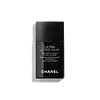Chanel Ultra Le Teint Velvet Foundation Versus Makeup by Mario Surrealskin Natural Finish Foundation
What's inside
What's inside
 Key Ingredients
Key Ingredients

 Benefits
Benefits

 Concerns
Concerns

 Ingredients Side-by-side
Ingredients Side-by-side

Water
Skin ConditioningIsododecane
EmollientHydrogenated Polyisobutene
EmollientDimethicone
EmollientDicaprylyl Carbonate
EmollientAlcohol
AntimicrobialCellulose
AbsorbentVinyl Dimethicone/Methicone Silsesquioxane Crosspolymer
Synthetic Fluorphlogopite
PEG-9 Polydimethylsiloxyethyl Dimethicone
EmulsifyingIsodecyl Neopentanoate
EmollientPropylene Glycol Dicaprylate
EmollientStearalkonium Hectorite
Gel FormingSodium Chloride
MaskingMaltodextrin
AbsorbentDimethicone/Bis-Isobutyl PPG-20 Crosspolymer
EmollientPotassium Sorbate
PreservativePropylene Carbonate
SolventParfum
MaskingAluminum Hydroxide
EmollientTocopherol
AntioxidantSodium Lauroyl Glutamate
Biosaccharide Gum-1
HumectantLysine
Skin ConditioningMagnesium Chloride
CI 77007
Cosmetic ColorantCI 77491
Cosmetic ColorantCI 77492
Cosmetic ColorantCI 77499
Cosmetic ColorantCI 77891
Cosmetic ColorantMica
Cosmetic ColorantWater, Isododecane, Hydrogenated Polyisobutene, Dimethicone, Dicaprylyl Carbonate, Alcohol, Cellulose, Vinyl Dimethicone/Methicone Silsesquioxane Crosspolymer, Synthetic Fluorphlogopite, PEG-9 Polydimethylsiloxyethyl Dimethicone, Isodecyl Neopentanoate, Propylene Glycol Dicaprylate, Stearalkonium Hectorite, Sodium Chloride, Maltodextrin, Dimethicone/Bis-Isobutyl PPG-20 Crosspolymer, Potassium Sorbate, Propylene Carbonate, Parfum, Aluminum Hydroxide, Tocopherol, Sodium Lauroyl Glutamate, Biosaccharide Gum-1, Lysine, Magnesium Chloride, CI 77007, CI 77491, CI 77492, CI 77499, CI 77891, Mica
Water
Skin ConditioningDimethicone
EmollientCaprylic/Capric Triglyceride
MaskingMethyl Trimethicone
Skin ConditioningLauryl Dimethicone
Skin ConditioningLauryl PEG-10 Tris(Trimethylsiloxy)Silylethyl Dimethicone
EmulsifyingButylene Glycol
HumectantGlycerin
HumectantTrimethylsiloxysilicate
EmollientCellulose
AbsorbentC13-15 Alkane
SolventSd Alcohol 40-B
AstringentSorbitan Isostearate
EmulsifyingAluminum/Magnesium Hydroxide Stearate
Emulsion StabilisingDimethicone/Vinyl Dimethicone Crosspolymer
Skin ConditioningSodium Chloride
MaskingTriethoxycaprylylsilane
Ethylhexylglycerin
Skin ConditioningPotassium Sorbate
PreservativeSodium Benzoate
MaskingSodium Dehydroacetate
PreservativeTocopheryl Acetate
AntioxidantPhytic Acid
Tocopherol
AntioxidantRubus Idaeus Leaf Extract
Skin ConditioningIron Oxides
CI 77891
Cosmetic ColorantWater, Dimethicone, Caprylic/Capric Triglyceride, Methyl Trimethicone, Lauryl Dimethicone, Lauryl PEG-10 Tris(Trimethylsiloxy)Silylethyl Dimethicone, Butylene Glycol, Glycerin, Trimethylsiloxysilicate, Cellulose, C13-15 Alkane, Sd Alcohol 40-B, Sorbitan Isostearate, Aluminum/Magnesium Hydroxide Stearate, Dimethicone/Vinyl Dimethicone Crosspolymer, Sodium Chloride, Triethoxycaprylylsilane, Ethylhexylglycerin, Potassium Sorbate, Sodium Benzoate, Sodium Dehydroacetate, Tocopheryl Acetate, Phytic Acid, Tocopherol, Rubus Idaeus Leaf Extract, Iron Oxides, CI 77891
Ingredients Explained
These ingredients are found in both products.
Ingredients higher up in an ingredient list are typically present in a larger amount.
Cellulose is the main component of plant cell walls. It is used as an emulsifier, absorbent, and texture enhancer.
This ingredient has many functions:
Fun fact: Cellulose is the most abundant form of organic polymer on Earth.
Learn more about CelluloseCi 77891 is a white pigment from Titanium dioxide. It is naturally found in minerals such as rutile and ilmenite.
It's main function is to add a white color to cosmetics. It can also be mixed with other colors to create different shades.
Ci 77891 is commonly found in sunscreens due to its ability to block UV rays.
Learn more about CI 77891Dimethicone is a type of synthetic silicone created from natural materials such as quartz.
What it does:
Dimethicone comes in different viscosities:
Depending on the viscosity, dimethicone has different properties.
Ingredients lists don't always show which type is used, so we recommend reaching out to the brand if you have questions about the viscosity.
This ingredient is unlikely to cause irritation because it does not get absorbed into skin. However, people with silicone allergies should be careful about using this ingredient.
Note: Dimethicone may contribute to pilling. This is because it is not oil or water soluble, so pilling may occur when layered with products. When mixed with heavy oils in a formula, the outcome is also quite greasy.
Learn more about DimethiconePotassium Sorbate is a preservative used to prevent yeast and mold in products. It is commonly found in both cosmetic and food products.
This ingredient comes from potassium salt derived from sorbic acid. Sorbic acid is a natural antibiotic and effective against fungus.
Both potassium sorbate and sorbic acid can be found in baked goods, cheeses, dried meats, dried fruit, ice cream, pickles, wine, yogurt, and more.
You'll often find this ingredient used with other preservatives.
Learn more about Potassium SorbateChances are, you eat sodium chloride every day. Sodium Chloride is also known as table salt.
This ingredient has many purposes in skincare: thickener, emulsifier, and exfoliator.
You'll most likely find this ingredient in cleansers where it is used to create a gel-like texture. As an emulsifier, it also prevents ingredients from separating.
There is much debate on whether this ingredient is comedogenic. The short answer - comedogenic ratings don't tell the whole story. Learn more about comegodenic ratings here.
The concensus about this ingredient causing acne seems to be divided. Research is needed to understand if this ingredient does cause acne.
Scrubs may use salt as the primary exfoliating ingredient.
Learn more about Sodium ChlorideTocopherol (also known as Vitamin E) is a common antioxidant used to help protect the skin from free-radicals and strengthen the skin barrier. It's also fat soluble - this means our skin is great at absorbing it.
Vitamin E also helps keep your natural skin lipids healthy. Your lipid skin barrier naturally consists of lipids, ceramides, and fatty acids. Vitamin E offers extra protection for your skin’s lipid barrier, keeping your skin healthy and nourished.
Another benefit is a bit of UV protection. Vitamin E helps reduce the damage caused by UVB rays. (It should not replace your sunscreen). Combining it with Vitamin C can decrease sunburned cells and hyperpigmentation after UV exposure.
You might have noticed Vitamin E + C often paired together. This is because it is great at stabilizing Vitamin C. Using the two together helps increase the effectiveness of both ingredients.
There are often claims that Vitamin E can reduce/prevent scarring, but these claims haven't been confirmed by scientific research.
Learn more about TocopherolWater. It's the most common cosmetic ingredient of all. You'll usually see it at the top of ingredient lists, meaning that it makes up the largest part of the product.
So why is it so popular? Water most often acts as a solvent - this means that it helps dissolve other ingredients into the formulation.
You'll also recognize water as that liquid we all need to stay alive. If you see this, drink a glass of water. Stay hydrated!
Learn more about Water